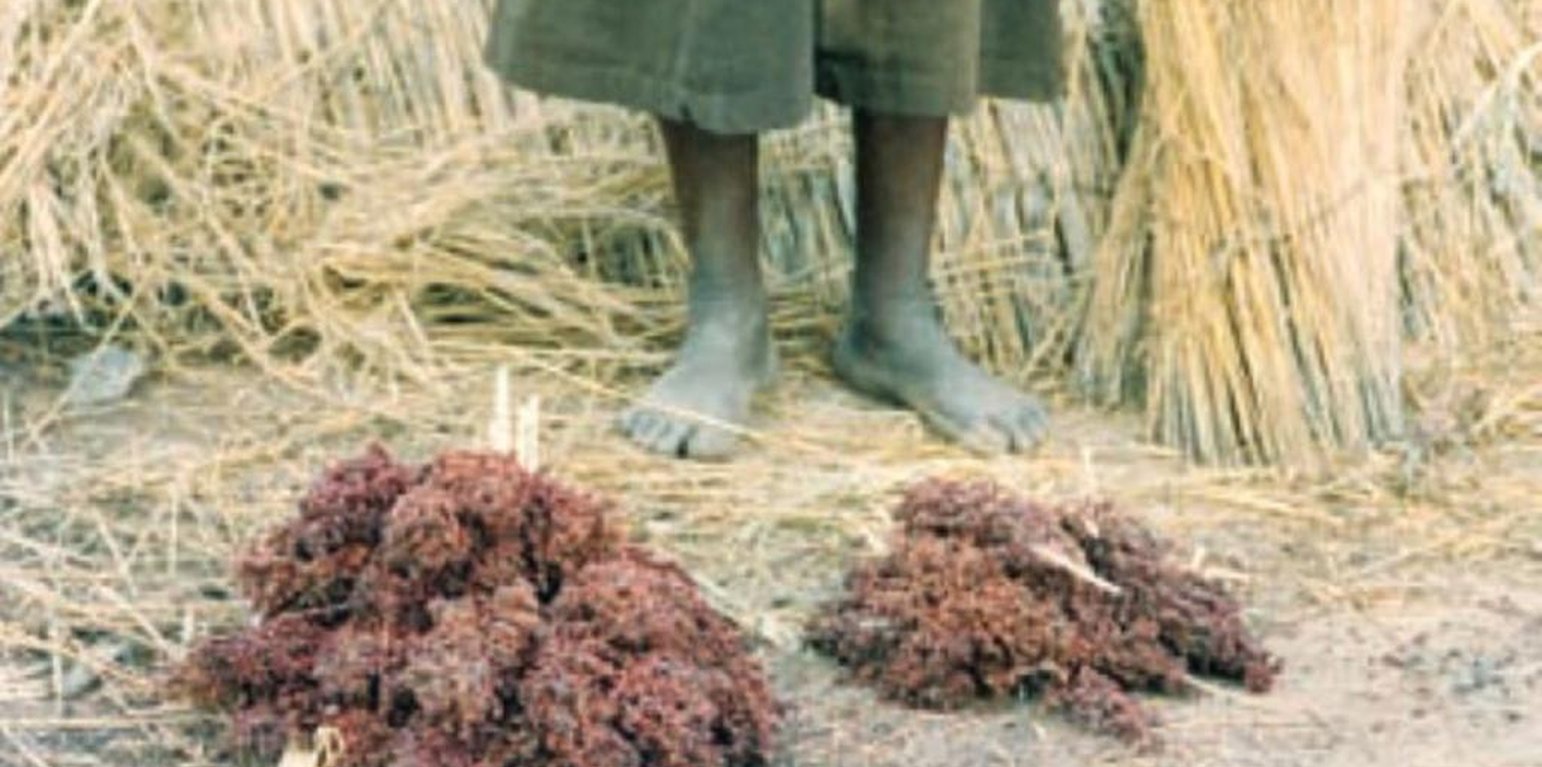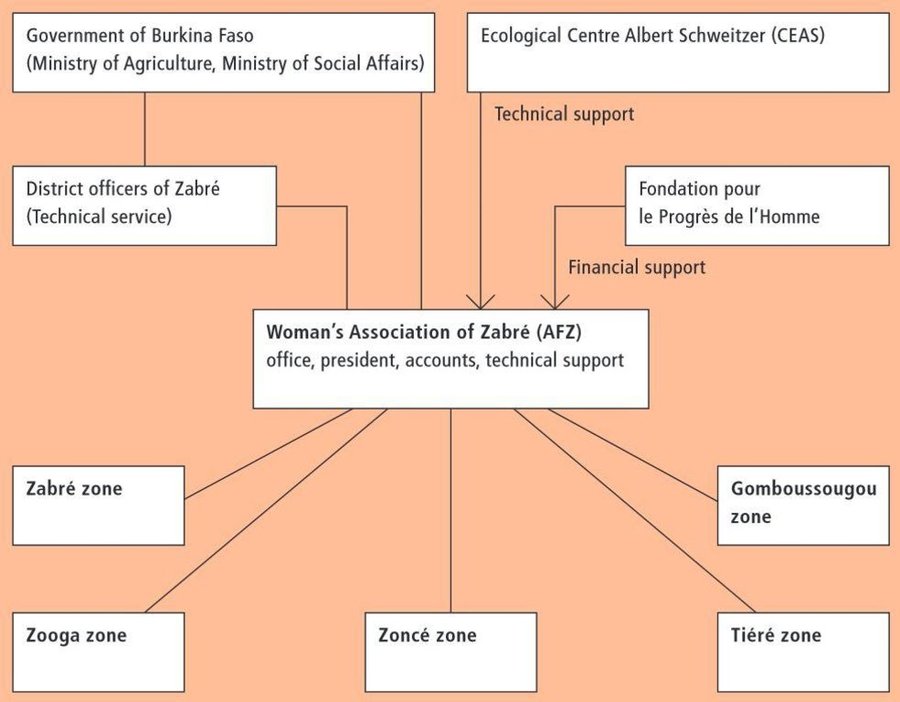Zabré women’s agroecological programme
(بوركينا فاسو)
الوصف
A demand-driven initiative, by a women’s association, aimed at the promotion of composting through training and extension, using project staff and local facilitators.
Aims / objectives: Leaders of the women’s association of Zabré (Association des Femme de Zabré, AFZ) initiated a training programme for their members on compost making, and its application in planting pits (zai) after they visited a seminar on the topic in 1987. AFZ actively sought technical and financial help, and found this through the Centre Ecologique Albert Schweitzer (CEAS, based in Switzerland). Support began with the establishment of a first demonstration site where five local facilitators (one from each zone), learned about and developed the technology together over a whole year - comparing the results with sorghum fields without compost. In the following year, those five facilitators each trained 20 women in their zones, using the same training methods as they themselves had experienced. AFZ set up demonstration and training sites in each of the five zones. These demonstration areas were protected by a wire netting fence, contained a well, a cement water tank, and some shade trees for the compost heaps and training sessions. Machines for the wells, hand tools and manure were fully financed, whereas community infrastructure was only partly funded. Each demonstration site had one hectare of cultivated land, with irrigated vegetables in the dry season and sorghum in the rainy season. The facilitators used this land to demonstrate the effect of the compost, and thus to visually convince the trainees. Each of the trainees carried 20 kg of compost home and applied it to their own sorghum fields. During the first 18 months, a CEAS technician visited the zones regularly.
Methods: In the following years, the neighbouring villages each sent groups of 20 women to the established demonstration and training sites, each group for one day a week. They carried out the successive phases of composting in the demonstration plots, while simultaneously implementing the practice at home - where they were supervised by the facilitators as far as possible. In this way, 500 women were trained within one year. Although it took a while, men gradually began to take part and assist their wives when they lost their fear of being ridiculed by others. Many more women then put themselves forward for training. While waiting, they tried to imitate their neighbours, but with mixed results. The support of the CEAS project decreased over the years until 1997, after which it was phased out, being no longer necessary. Training has since continued through the five zonal facilitators and the local agriculture extension service.
الموقع
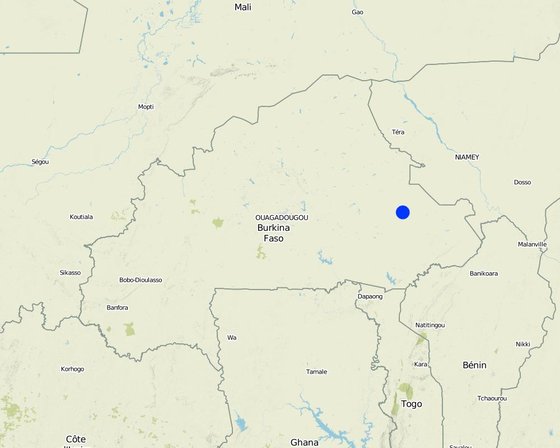
الموقع: Boulgou Province, بوركينا فاسو
المرجع الجغرافي للمواقع المختارة
تاريخ البدء: 1987
سنة الإنهاء: 1997
نوع النهج
-
تقليدي/أصلي
-
مبادرة محلية حديثة/مبتكرة
-
قائم على مشروع/برنامج
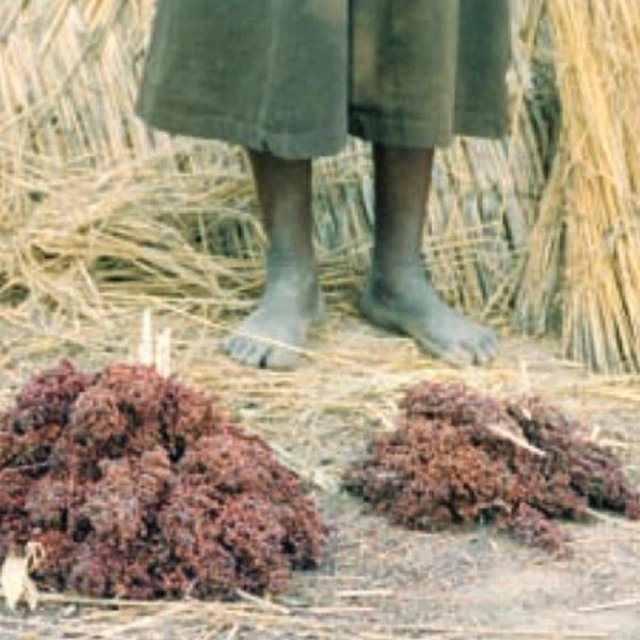
Result of the technology: sorghum yield (25 heads) grown with compost (left) and 25 heads without compost. On-farm trials are used to compare yields between plots with, and without, compost. (Reynold Chatelain)
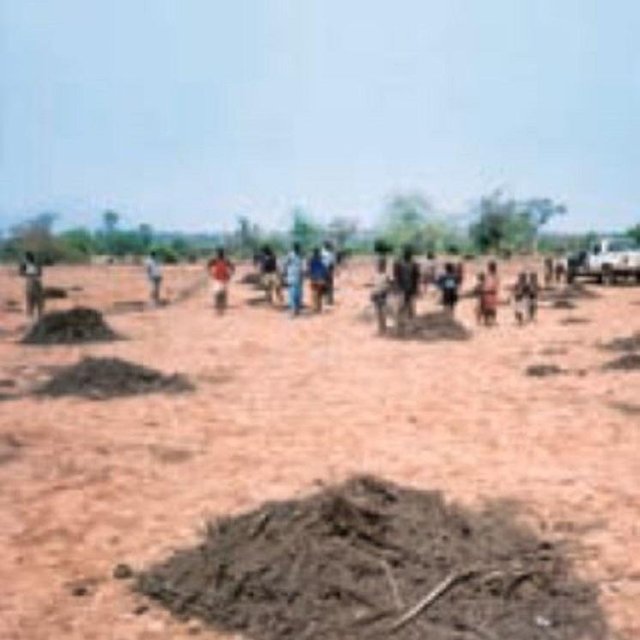
Heaps of compost in the field prior to planting. (Moussa Bonzi)
غايات النهج والبيئة المواتية
الغايات/الأهداف الرئيسية للنهج
- train 6,000 women members of AFZ (in 1987) in making compost, and applying it to planting pits (zai) in order to double yields of sorghum or maize - the eventual target is for all farmers of the two departments to make, and apply compost on their fields, - improve the status of women and their livelihoods, - encourage women’s participation in development, - promote training and cooperative action
The SLM Approach addressed the following problems: Since the drought and famine periods of 1970-74 and 1981-84, the main concern of the women in Zabré was how to feed their families. This meant trying to raise crop production again to the pre-1970s average of 800 kg/ha from the level of 400 kg/ha to which it had fallen. The soils were deteriorating because of declining organic matter as increased population led to continuous cultivation without fallow periods. The status of women was low, and they found it hard to generate income through other activities.
الشروط التي تمكن من تنفيذ التقنية/التقنيات المطبقة في إطار النهج
-
الإطار القانوني (حيازة الأراضي، وحقوق استخدام الأراضي والمياه): Even though the land users do not own the land they cultivate (the state officially owns the land, though land use rights are traditional and secure) they receive immediate and full benefits through improved crop yields.
الظروف التي تعيق تنفيذ التقنية/التقنيات المطبقة في إطار النهج
-
المعايير والقيم الاجتماعية /الثقافية/ الدينية: Men were afraid of being ridiculed in case of failures.
Treatment through the SLM Approach: Contrastingly, women don’t fear being laughed at. The expectation of increasing the yields encourages them to take risks: eventually men also followed for the same reasons.
-
توفر/الوصول إلى الموارد والخدمات المالية: Training of farmers is relatively expensive.
Treatment through the SLM Approach: The donors (Fondation pour le Progrés de l'Homme) and CEAS took care of the approach costs.
-
الإطار المؤسساتي: The existing institution of the women’s association of Zabré (AFZ), which has functioned well for 12 years, needed to adapt to the new agroecological programme promoted by CEAS.
Treatment through the SLM Approach: The management of the AFZ was motivated to adopt and integrate the technology offered by CEAS.
-
الإطار القانوني (حيازة الأراضي، وحقوق استخدام الأراضي والمياه): None
-
المعرفة حول الإدارة المستدامة للأراضي، والوصول إلى الدعم الفني: One key question was: how best to teach composting to 6,000 women?
Treatment through the SLM Approach: AFZ already had an extension structure and the five facilitators served as ‘multipliers’
مشاركة وأدوار الأطراف المعنية
الأطراف المعنية بالنهج وأدوارها
| ما هي الجهات المعنية / الكيانات المنفذة التي شاركت في النهج؟ |
حدد الأطراف المعنيين |
وصف أدوار الأطراف المعنية |
| مستخدمو الأراضي المحليون/المجتمعات المحلية |
There were great differences - in the beginning at least - when AFZ merely asked the men to ‘allow’ their wives to learn about composting. After two years, men started to participate in the training and eventually as many of them as women began to make and use compost. Another difference was in discussions, when men tended to dominate. |
|
| متخصصون في الإدارة المستدامة للأراضي / مستشارون زراعيون |
|
|
| منظمة دولية |
|
|
| AFZ |
Leaders of the women's association of Zabré |
|
انخراط مستخدمي الأراضي المحليين/المجتمعات المحلية في المراحل المختلفة للنهج
غير موجود
سلبي
الدعم الخارجي
تفاعلي
التعبئة الذاتية
المبادرة/التحفيز
discussion of problems in public meetings
التخطيط
meetings with those in charge of the groups of women farmers
التنفيذ
in exchange for the training received, some land users volunteered themselves as temporary/part-time facilitators
الرصد/التقييم
the land users learned to control the quality and the efficiency of their work and voluntarily contributed to monitoring/evaluation - the facilitators were responsible for progress reports
Research
visit of international researchers to the farms
مخطط التدفق
The agroecological programme of the Zabré Women's Association (AFZ). There are five facilitator’s zones each with:
- 1 president, 1 vice-president
- 1 facilitator
- 1 pharmacy
- 1 cereal bank
- 1 meeting room
- 1 shop
- 1 demonstration/training site
اتخاذ القرار بشأن اختيار تقنية الإدارة المستدامة للأراضي
وقد تم اتخاذ القرارات من قبل
-
مستخدمو الأراضي وحدهم (المبادرة الذاتية)
-
مستخدمو الأراضي بشكل أساسي، بدعم من متخصصي الإدارة المستدامة للأراضي
-
جميع الجهات الفاعلة ذات الصلة، كجزء من نهج تشاركي
-
متخصصون في الإدارة المستدامة للأراضي بشكل أساسي، بعد التشاور مع مستخدمي الأراضي
-
متخصصون في الإدارة المستدامة للأراضي بمفردهم
-
السياسيون / القادة
-
Leaders of the women's association of Zabré (AFZ)
تم اتخاذ القرارات بناء على
-
تقييم المعرفة الموثقة جيدًا بشأن الإدارة المستدامة للأراضي(اتخاذ القرارات القائمة على الأدلة)
-
نتائج البحوث
-
خبرة وآراء شخصية(غير موثقة)
الدعم الفني وبناء القدرات وإدارة المعرفة
شكلت الأنشطة أو الخدمات التالية جزءًا من النهج
-
بناء القدرات/التدريب
-
خدمة استشارية
-
تعزيز المؤسسات (التطوير التنظيمي)
-
الرصد والتقييم
-
البحوث
بناء القدرات/التدريب
تم تقديم التدريب للأطراف المعنية التالية
-
مستخدمو الأراضي
-
موظفون ميدانيون/ مستشارون
شكل التدريب
-
في العمل
-
من مزارع إلى مزارع
-
مناطق العرض
-
اجتماعات عامة
-
دورات
-
on-farm training
المواضيع المغطاة
Training, as the central focus of the approach, was provided on two levels: project staff trained local facilitators, who then further spread the gained SWC knowledge among the land users. Subjects treated included compost making and application, reforestation, soil protection and anti-erosion measures. station training.
خدمة استشارية
تم تقديم الخدمة الاستشارية
-
في حقول مستخدمي الأراضي
-
في مراكز دائمة
Key elements: demonstrations and practical training of of AFZ’s members in the five demonstrationareas in the respective AFZ zones.
تعزيز المؤسسات
تم تعزيز/إنشاء المؤسسات
-
لا
-
نعم، قليلا
-
نعم، باعتدال
-
نعم، إلى حد كبير
صف المؤسسة والأدوار والمسؤوليات والأعضاء وما إلى ذلك.
نوع الدعم
-
مالي
-
بناء القدرات/التدريب
-
معدات
مزيد من التفاصيل
الرصد والتقييم
bio-physical aspects were regular monitored by 0 through observations; indicators: colour, texture and temperature of compost
technical aspects were regular monitored by 0 through observations; indicators: learning progress and production
socio-cultural aspects were ad hoc monitored by 0 through observations; indicators: effects on input and product prices
economic / production aspects were regular monitored by 0 through measurements; indicators: agricultural output
area treated aspects were regular monitored by 0 through observations; indicators: fields with compost
no. of land users involved aspects were regular monitored by 0 through observations; indicators: trained land users and implementers of technology
management of Approach aspects were regular monitored by 0 through measurements; indicators: CEAS' accounting expertise
There were no changes in the Approach as a result of monitoring and evaluation
البحوث
تناول البحث المواضيع التالية
-
علم الاجتماع
-
الاقتصاد / التسويق
-
علم الايكولوجيا
-
تكنولوجيا
Applied research was not part of this approach. However CEAS used previous recommendations from an applied research station in Gorom (Burkina Faso) and thereby adapted the technology to the local situation.
التمويل والدعم المادي الخارجي
الميزانية السنوية بالدولار الأمريكي لمكون الإدارة المستدامة للأراضي
-
< 2000
-
10,0000-2,000
-
100,000-10,000
-
1,000000-100،000
-
> 1,000,000
Precise annual budget: غير متاح
Approach costs were met by the following donors: international (CEAS&Fondation pour le progrés del'homme): 80.0%; government (national): 20.0%
تم تقديم الخدمات أو الحوافز التالية لمستخدمي الأراضي
-
الدعم المالي/المادي المقدم لمستخدمي الأراضي
-
إعانات لمدخلات محددة
-
الائتمان
-
حوافز أو وسائل أخرى
الدعم المالي/المادي المقدم لمستخدمي الأراضي
معدات: الآلات
machines for the wells on demonstration areas
العمل من قبل مستخدمي الأراضي كان
-
تطوعي
-
الغذاء مقابل العمل
-
مدفوع نقدا
-
مقابل دعم مادي آخر
تحليل الأثر والتصريحات الختامية
آثار النهج
لا
نعم، قليلا
نعم، باعتدال
نعم، إلى حد كبير
هل ساعد النهج مستخدمي الأراضي على تنفيذ وصيانة تقنيات الإدارة المستدامة للأراضي؟
The compost making and its application has helped to improve soil and water management, as the compost returns humus to the soil and increases its water retention capacity and thus improves ground cover.
Did other land users / projects adopt the Approach?
Many women's groups from other regions throughout the country invite delegations from AFZ to teach them compost making. The AFZ delegates are provided with food, accommodation, travel costs and presents in exchange for training. This is much cheaper than the 'official' compost training provided by the Association for Agroecological Technology Development (ADTAE).
المحفز الرئيسي لقيام مستخدمي الأراضي بتنفيذ الإدارة المستدامة للأراضي
استدامة أنشطة النهج
هل يمكن لمستخدمي الأراضي الحفاظ على استدامة ما تم تنفيذه من خلال النهج (بدون دعم خارجي)؟
The land users are continuing activities and can do so in future, assuming no new problems arise.
الاستنتاجات والدروس المستفادة
نقاط القوة: وجهة نظر مستخدم الأرض
نقاط القوة: وجهة نظر جامع المعلومات أو غيره من الأشخاص الرئيسيين لمصدر المعلومات
-
Land users have confidence in their organisation (AFZ) and learn while working in the fields and discussing with the facilitators (How to sustain/ enhance this strength: The facilitators know to nurture this confidence until the land users get profit from the compost (which in turn reinforces that confidence).)
-
AFZ was convinced about the necessity of compost before they knew about CEAS. They searched for a technical collaborator for training and financial support (How to sustain/ enhance this strength: This preliminary motivation is an asset and the technical partner has to fulfil neither less, nor more, than what AFZ expects.)
-
Training of local trainers/facilitators (How to sustain/ enhance this strength: Positive feedback from the farmers will stimulate the facilitators to continue their work.)
-
AFZ represents female land users, it is local and not 'created' by CEAS and is thus an ideal structure (How to sustain/ enhance this strength: CEAS has the knowledge, but AFZ has the power. AFZ needs to learn to use its power to access CEAS' knowledge bank.)
نقاط الضعف / المساوىء / المخاطر: وجهة نظر مستخدم الأرضكيفية التغلب عليها
نقاط الضعف / المساوىء / المخاطر: وجهة نظر جامع المعلومات أو غيره من الأشخاص الرئيسيين لمصدر المعلوماتكيفية التغلب عليها
-
Internal conflicts within the association may cause problems and there is a danger of CEAS specialists becoming involved in these AFZ rivalries
CEAS should be aware of AFZ power struggles and not get involved. CEAS must stick to its technical role - which is related to knowledge only and not to power.
المراجع
المُراجع
-
David Streiff
-
Deborah Niggli
تاريخ التوثيق: 31 ديسمبر، 2008
اخر تحديث: 4 إبريل، 2018
الأشخاص الرئيسيين لمصدر المعلومات
-
Maria Lougue - متخصص في الإدارة المستدامة للأراضي
-
Jean Pascal Etienne De Pury (ceas.ne@bluewin.ch) - متخصص في الإدارة المستدامة للأراضي
الوصف الكامل في قاعدة بيانات WOCAT
بيانات الإدارة المستدامة للأراضي المرتبطة
تم تسهيل التوثيق من قِبَل
المؤسسة
- Centre Ecologique Albert Schweitzer (CEAS) - سويسرا
المشروع
- Book project: where the land is greener - Case Studies and Analysis of Soil and Water Conservation Initiatives Worldwide (where the land is greener)
المراجع الرئيسية
-
UNEP (2002) Enriching soils naturally. In: Success stories in the struggle against desertification pp 5-8:
-
UNEP (2002) Enriching soils naturally. In: Success stories in the struggle against desertification pp 5-8:
